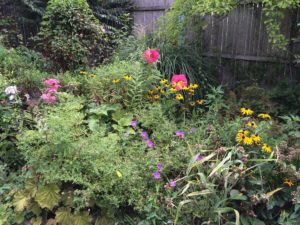
Grasses and Hibiscus moscheutos at water’s edge – Aberdeen Creek flows into the Chesapeake Bay – taken last summer on APLD tour
What perennial has flowers as large as dinner plates? I can only think of one and that is Hibiscus. Hibiscus moscheutos (Common Mallow) grows wild along the shores of the East Coast and is hardy to zone 5. Most of the old cultivars grow quite large but the hybridized cultivars we see in the trade today have been bred for cold hardiness, gorgeous flowers and, especially, more compact growth habit. However, compact does not necessarily mean small, merely dense.

Hibiscus ‘Pinot Noir’ in my garden last summer

Hibiscus ‘Pinot Grigio’ in my garden two summers ago
The maple-like leaves are large and lovely unless they’ve been decimated by Japanese beetles but I have not seen these pests as a problem in the Cleveland area. I fell in love with two of the truly compact cultivars several years ago, ‘Pinot Noir’ and ‘Pinot Grigio’. Each one grows only two and a half feet high and wide, making quite a statement as a specimen plant. ‘Pinot Noir’ has huge, ruby red flowers while those of ‘Pinot Grigio’ are white with a dark rose eye. As the blossom ages, it develops a pale pink rim. Another cultivar in the Vintage Series is ‘Bordeaux’, a deep pink that grows a bit taller to three feet. These were all developed by Yoder. All three if these cultivars fit right in to the middle of my borders.

Hibiscus ‘Cranberry Crush’ with Xanthosoma and Canna in a container at the back of my driveway

Hibiscus ‘Heartthrob’ in back driveway container last summer

Hibiscus ‘Summer Storm’ in back garden with Phlox ‘Blushing Shortwood’ and ‘Coral Creme Drop’, Rudbeckia, Anemone ‘September Charm’, Geranium ‘Rozanne’, and Tradescantia
Walters Gardens has also been developing Hibiscus cultivars, the most notable of which are ‘Cranberry Crush’, ‘Heartthrob’, and ‘Summer Storm’. ‘Cranberry Crush’is a true red with overlapping petals and only four feet tall and wide. ‘Heartthrob’ is a strong, dark red that grows to four feet. Both are better suited to the back of a border or the middle of a deep border. ‘Summer Storm’ is light pink with rose red veins that bleed into the petal until it is rose pink with a red eye. It has dark leaves and will supposedly grow seven feet high. Happily, for me, it has only grown four and a half feet high.
All of these Hibiscus cultivars are deer and rabbit resistant. Grow them in full sun with lots of moisture. I have found, however, that they will bloom in part shade as long as they still receive bright light for at least half of the day.
Two warnings. One – Hibiscus foliate very late so leave the stalks up during the winter to mark their spot. I planted my first Hibiscus in spring of 2005. The following April, I looked at it and, unknowingly, decided it was dead. Therefore, I got out my spade and proceeded to dig it up. However, as soon as I saw the roots, I realized that it was merely dormant and replanted it. Do not expect Hibiscus to foliate until late May in the Cleveland area. Thus a word to the wise. Second – Deadheading is essential to its appearance. The browned flowers look like used condoms. Happily, they break off quite easily. Once your plant starts blooming, it will keep blooming into October.
If you want a perennial with impact, Hibiscus is it.


0 Comments